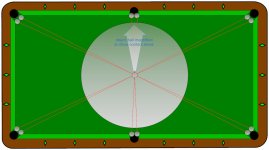Patrick Johnson[B said:]"Adjustments" are an acknowledged part of this system:[/B]
I don't know anyone who suggests that there are no adjustments ever needed. Of course, I said precisely that there were such adjustments and so did bluepepper so I don't know why you felt the need to repeat the repeated...but there are VERY, VERY few adjustments required for the BASELINE aiming method.
But as for the details of the method to which I refer...Pro One...how much time have you spent with Stan Shuffett to learn his approach to the aiming method?
Obviously the system itself doesn't specify each of the infinite varieties of bridge hand and cue alignment - these are the "adjustments" required by the system, chosen by the shooter by experience or feel.
That statement is UTTERLY INCORRECT and demonstrates that you have no idea about the fundamentals of Pro One...regardless of whether anyone ever attempted to teach them to you or not.
There is only ONE bridge hand position relative to the center-to-edge line
There simply is no system that can, just by following its "rules", mechanically specify enough cut angles to sink every possible shot - or even close to it. It's an obvious impossibility that requires no experience with the system to know.
The very ESSENCE of Pro One is the rote, automatic and completely systematic achievement of the correct bridge hand placement and cue alignment.
pjThose who insist this is an unfounded assertion made by those who don't understand the system(s) themselves don't understand the simple, irrefutable logic behind it, and in fact don't fully understand their own system(s). This has been the basis for most of the heated argument about these "aiming simplification" systems since the first ones were described (imperfectly then as now) on the internet years ago.
chgo
No, sophistry just as you have engaged in above by commenting on the dynamics of a system that you have either never been taught by its creater*** or were not competent to understand, is what has caused the heated debates to which you refer.
***Pro One, EVOLVED from the center-to-edge method pioneered by Mr. Houle as Stan never hesitates to mention...but has been substantially refined by Stan both in terms of its dynamics and the way it is taught.
The ONLY adjustments required are when the CB/OB are extremely close together...or when there IS no realistic pocket such as the cross-side banks I mentioned an d when certain forms of english are used.
But as for shots with english, it is FAR better to determine the necessary adjustments from the CORRECT baseline aim (i.e. center ball) and not guess about BOTH the base aim AND the adjustment required.
You should really take the time to become knowledgable about the CORRECT method before you jump in to criticize that about which you are not well informed.
Jim
